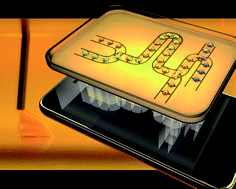Electrowetting-on-dielectric (EWOD) promises to be an important lab-on-a-chip approach for effectively manipulating droplets with electric field-controlled surface tension. Droplets manipulated in electrowetting-based devices are typically sandwiched between two parallel plates and actuated by digital electrodes. The size of pixilated electrodes limits the minimum droplet size that can be manipulated. Here, we report on a single-sided continuous optoelectrowetting (SCOEW) mechanism that enables light-patterned electrowetting modulation for continuous droplet manipulation on an open, featureless, and photoconductive surface. SCOEW overcomes the size limitation of physical pixilated electrodes by utilizing dynamic and reconfigurable optical patterns and enables the continuous transport, splitting, merging, and mixing of droplets with volumes ranging from 50 μL to 250 pL, over 5-orders of magnitude. This single-sided open configuration provides a flexible interface for integration with other microfluidic components, such as sample reservoirs through simple tubing. Light-triggered, parallel, and volume-tunable droplet injection with volume variation less than 1% has been demonstrated with SCOEW. The unique lateral field-driven optoelectrowetting mechanism also enables extremely low light intensity actuation, and droplet manipulation can be achieved by directly positioning the SCOEW chip on a LCD screen used in a laptop or portable cellular phone.

You have access to this article
 Please wait while we load your content...
Something went wrong. Try again?
Please wait while we load your content...
Something went wrong. Try again?


 Please wait while we load your content...
Please wait while we load your content...